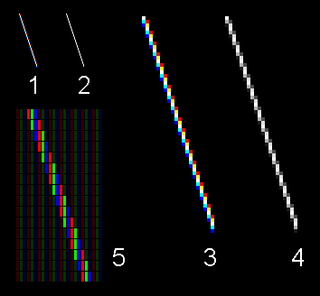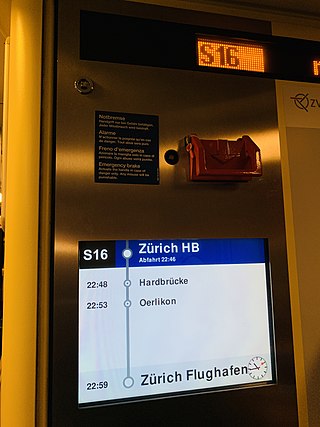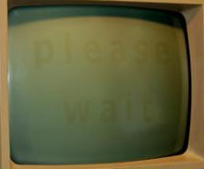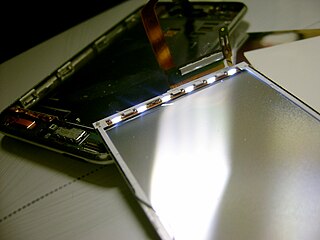Related Research Articles

A computer monitor is an output device that displays information in pictorial or textual form. A discrete monitor comprises a visual display, support electronics, power supply, housing, electrical connectors, and external user controls.

ClearType is Microsoft's implementation of subpixel rendering technology in rendering text in a font system. ClearType attempts to improve the appearance of text on certain types of computer display screens by sacrificing color fidelity for additional intensity variation. This trade-off is asserted to work well on LCD flat panel monitors.

Electronic paper or intelligent paper, is a display device that reflects ambient light, mimicking the appearance of ordinary ink on paper - unlike conventional flat panel displays which need additional energy to emit their own light. This may make them more comfortable to read, and provide a wider viewing angle than most light-emitting displays. The contrast ratio in electronic displays available as of 2008 approaches newspaper, and newly developed displays are slightly better. An ideal e-paper display can be read in direct sunlight without the image appearing to fade.

A liquid-crystal display (LCD) is a flat-panel display or other electronically modulated optical device that uses the light-modulating properties of liquid crystals combined with polarizers. Liquid crystals do not emit light directly but instead use a backlight or reflector to produce images in color or monochrome.
In digital imaging, a pixel, pel, or picture element is the smallest addressable element in a raster image, or the smallest addressable element in a dot matrix display device. In most digital display devices, pixels are the smallest element that can be manipulated through software.

A flat-panel display (FPD) is an electronic display used to display visual content such as text or images. It is present in consumer, medical, transportation, and industrial equipment.

In color reproduction and colorimetry, a gamut, or color gamut, is a convex set containing the colors that can be accurately represented, i.e. reproduced by an output device or measured by an input device. Devices with a larger gamut can represent more colors. Similarly, gamut may also refer to the colors within a defined color space, which is not linked to a specific device. A trichromatic gamut is often visualized as a color triangle. A less common usage defines gamut as the subset of colors contained within an image, scene or video.
Liquid crystal on silicon is a miniaturized reflective active-matrix liquid-crystal display or "microdisplay" using a liquid crystal layer on top of a silicon backplane. It is also known as a spatial light modulator. LCoS initially was developed for projection televisions, but has since found additional uses in wavelength selective switching, structured illumination, near-eye displays and optical pulse shaping.

A video projector is an image projector that receives a video signal and projects the corresponding image onto a projection screen using a lens system. Video projectors use a very bright ultra-high-performance lamp, Xenon arc lamp, metal halide lamp, LED or solid state blue, RB, RGB or fiber-optic lasers to provide the illumination required to project the image. Most modern projectors can correct any curves, blurriness and other inconsistencies through manual settings.
Subpixel rendering is a method used to increase the effective resolution of a color display device. It takes advantage of each pixel's composition of individually addressable red, green, and blue components adjacent on the display matrix, called subpixels, and uses them as rendering units instead of pixels.

A backlight is a form of illumination used in liquid-crystal displays (LCDs) that provides illumination from the back or side of a display panel. LCDs do not produce light by themselves, so they need illumination to produce a visible image. Backlights are often used in smartphones, computer monitors, and LCD televisions. They are used in small displays to increase readability in low light conditions such as in wristwatches. Typical sources of light for backlights include light-emitting diodes (LEDs) and cold cathode fluorescent lamps (CCFLs).
A thin-film-transistor liquid-crystal display is a type of liquid-crystal display that uses thin-film-transistor technology to improve image qualities such as addressability and contrast. A TFT LCD is an active matrix LCD, in contrast to passive matrix LCDs or simple, direct-driven LCDs with a few segments.
This is a comparison of various properties of different display technologies.

Screen burn-in, image burn-in, ghost image, or shadow image, is a permanent discoloration of areas on an electronic visual display such as a cathode-ray tube (CRT) in an older computer monitor or television set. It is caused by cumulative non-uniform use of the screen.

Large-screen television technology developed rapidly in the late 1990s and 2000s. Prior to the development of thin-screen technologies, rear-projection television was standard for larger displays, and jumbotron, a non-projection video display technology, was used at stadiums and concerts. Various thin-screen technologies are being developed, but only liquid crystal display (LCD), plasma display (PDP) and Digital Light Processing (DLP) have been publicly released. Recent technologies like organic light-emitting diode (OLED) as well as not-yet-released technologies like surface-conduction electron-emitter display (SED) or field emission display (FED) are in development to supersede earlier flat-screen technologies in picture quality.
An electronic visual display is a display device that can display images, video, or text that is transmitted electronically. Electronic visual displays include television sets, computer monitors, and digital signage. They are ubiquitous in mobile computing applications like tablet computers, smartphones, and information appliances. Many electronic visual displays are informally referred to as screens.

An LED-backlit LCD is a liquid-crystal display that uses LEDs for backlighting instead of traditional cold cathode fluorescent (CCFL) backlighting. LED-backlit displays use the same TFT LCD technologies as CCFL-backlit LCDs, but offer a variety of advantages over them.

A quantum dot display is a display device that uses quantum dots (QD), semiconductor nanocrystals which can produce pure monochromatic red, green, and blue light. Photo-emissive quantum dot particles are used in LCD backlights or display color filters. Quantum dots are excited by the blue light from the display panel to emit pure basic colors, which reduces light losses and color crosstalk in color filters, improving display brightness and color gamut. Light travels through QD layer film and traditional RGB filters made from color pigments, or through QD filters with red/green QD color converters and blue passthrough. Although the QD color filter technology is primarily used in LED-backlit LCDs, it is applicable to other display technologies which use color filters, such as blue/UV active-matrix organic light-emitting diode (AMOLED) or QNED/MicroLED display panels. LED-backlit LCDs are the main application of photo-emissive quantum dots, though blue organic light-emitting diode (OLED) panels with QD color filters are now coming to market.
PenTile matrix is a family of patented subpixel matrix schemes used in electronic device displays. PenTile is a trademark of Samsung. PenTile matrices are used in AMOLED and LCD displays.
Mirasol may refer to:
References
- 1 2 "Interferometric Modulator (IMOD) Technology Overview" (PDF). Qualcomm. May 2008. Archived from the original (PDF) on 2016-03-31. Retrieved 2008-08-07.
- 1 2 3 4 Watters, Ethan (June 12, 2007). "Product design, nature's way". CNNMoney. Cable News Network.
- ↑ Gabryel (July 7, 2010). "Qualcomm mirasol launch its color e-Reader". GeeksHive blog.
- ↑ Simonite, Tom (November 15, 2011). "E-Reader Display Shows Vibrant Color Video". Technology Review. Massachusetts Institute of Technology.
- ↑ Miles, M.; Larson, E.; Chui, C.; Kothari, M.; Gally, B.; Batey, J. (2003), Digital Paper for Reflective Displays, SID International Symposium, Boston, Massachusetts, pp. 209–215
{{citation}}: CS1 maint: location missing publisher (link) - ↑ Waldrop 2007
- 1 2 USpatent 5835255,Miles, Mark W.,"Visible spectrum modulator arrays",published 1998-11-10, assigned to Etalon, Inc.
- 1 2 Daniel Eran Dilger. "Apple has taken over Qualcomm's IMOD Mirasol display lab in Taiwan". 2015.
- ↑ "Technology Briefing: Deals: Qualcomm To Acquire Iridigm". The New York Times. September 10, 2004.
- ↑ "mirasol". Qualcomm. Feb 2009.
- ↑ "Natural iridescence harnessed for reflective displays". EE Times. 26 July 2009. Retrieved 5 May 2011.
- ↑ Ultra Low-power Handset to Begin Shipping in China in 2008 Archived 2016-05-15 at the Portuguese Web Archive PRNewswire, Barcelona, Spain, February 11
Bibliography
- Waldrop, M. Mitchell (November 2007). "Brilliant Displays". Scientific American (print). Scientific American, Inc. pp. 94–97.
(subtitle) A new technology that mimics the way nature gives bright color to butterfly wings can make cell phone displays clearly legible, even in the sun's glare.
- Graham-Rowe, Duncan (October 2007). "Epaper Displays Video". Technology Review (print). Technology Review, Inc.
(subtitle) A novel electronic-paper display developed by Qualcomm can deliver high-quality video images, making it more versatile than other e-paper technologies.